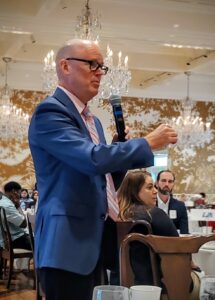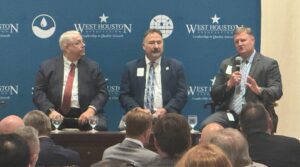The West Houston Association’s Partners in Progress: Public Partnerships for Regional Flood Resilience forum was not a morning of slide decks or technical reports—it was a very candid conversation about how Houston can better protect itself from flooding. The three panelists—Russ Poppe of the Fort Bend County Drainage District, Scott Elmer of the Harris County Flood Control District, and Stan Kitzman, the General Manager of the Brookshire-Katy Drainage District—were asked direct questions by moderator Alan Black, Vice President at Quiddity and Vice Chair of WHA’s Flood Control & Drainage Committee. Their answers revealed the challenges and opportunities of building resilience in a region where water is both a necessity and a threat.

Alan Black moderates part of the discussion from the floor, giving audience members an opportunity to ask the panelists questions directly.
Black set the tone early. “Resilience is a cornerstone of protecting communities—and in Greater Houston, that means taking flooding seriously,” he said. “Our region faces the constant challenge of managing too much water in too little time, often across multiple jurisdictions. True flood resilience depends on strong partnerships, especially collaboration between cities, counties, drainage districts, and regional and state agencies.” He added that one purpose of the day was to counter a misconception. “There’s a common misunderstanding often repeated, publicly and in the media, that none of the public agencies talk with each other. You and I know that’s simply not the case. The intent today is to give each of you the insight and information to help dispel those misunderstandings, but also to explore how collaborations can be improved upon.”
The first topic Black raised was one the public often struggles to understand: what is the difference between a drainage district and a flood control district? Elmer explained that flood control districts, like Harris County’s, are set up to deal with larger, more regional flood risks, whereas drainage districts typically handle smaller, localized systems. Poppe agreed, noting that “at the end of the day, both of us are moving water. It’s just a matter of scale.” Kitzman jumped in to add that the two types of entities must coordinate constantly. “Water doesn’t care about our boundaries. It’s going to go where it’s going to go. So if we’re not in sync, people flood.”
From there, the conversation shifted to state policy. Black asked about the Texas Legislature’s creation of the Texas Water Fund, which is designed to support long-term investments in water and flood infrastructure. Representative Kitzman described it as a game-changer. “This is not just another pot of money,” he said. “By dedicating state funds, we’re putting in place something permanent. Communities need certainty if they’re going to build big projects, and this gives them that certainty.” Kitzman stressed the importance of the constitutional amendment that voters will decide this November. “If Proposition 4 doesn’t pass, that fund doesn’t have the backbone it needs. This is about whether Texas is serious about water and flood for the long haul.” Poppe agreed, adding, “If we want to plan 50 years ahead—and we should—this is how you start.”


 But funding is never simple. Poppe described the challenges of relying on federal Community Development Block Grant funds. “Those dollars have been critical for us, but the implementation process is arduous and the funding comes with strings. The timing often doesn’t match the urgency of the projects.” Elmer nodded in agreement, saying Harris County has run into the same issue. “You can have a project ready to go, but if the funding isn’t aligned, you lose momentum. And when people are waiting for flood relief, momentum matters.”
But funding is never simple. Poppe described the challenges of relying on federal Community Development Block Grant funds. “Those dollars have been critical for us, but the implementation process is arduous and the funding comes with strings. The timing often doesn’t match the urgency of the projects.” Elmer nodded in agreement, saying Harris County has run into the same issue. “You can have a project ready to go, but if the funding isn’t aligned, you lose momentum. And when people are waiting for flood relief, momentum matters.”
That led naturally into a discussion of public-to-public partnerships, which all three panelists agreed have shown some of the most promise. Elmer cited Harris County’s collaboration with the City of Houston, and other local, state and federal agencies, on detention projects as an example of how entities can leverage each other’s resources. Poppe pointed to joint projects with neighboring jurisdictions that helped Fort Bend address challenges along the Brazos River. Kitzman reflected on his own experience at the Brookshire-Katy Drainage District. “It’s never perfect. But if we’re willing to sit down and talk honestly about what went right and what went wrong, we can take those lessons and do better next time.”
The panel did not shy away from the setbacks. Elmer acknowledged that the Memorial Park Demonstration Project had been more complicated than anticipated, with lessons about communication and expectations. Poppe described the challenge of learning the CDBG process while implementing the project with a sense of urgency. Rather than papering over these challenges, the panelists framed them as evidence of why transparency matters. “People need to know that we’re learning as we go,” Poppe said. “If we’re honest about the struggles, it builds trust for the next partnership.”

L to R: State Representative Stan Kitzman, Scott Elmer, and Russ Poppe.
Black also raised the question of advocacy. What role can groups like Houston Stronger play? Elmer said they are essential. “Houston Stronger can speak across jurisdictions in a way we sometimes can’t. They keep the focus on resilience as a regional priority.” Kitzman added that such organizations can help communicate with the public. “If you don’t explain to people why a tunnel or a reservoir matters, they’re not going to support it. Advocacy groups help us tell the story.”
One of the most compelling threads of the conversation was about projects that serve both water supply and flood control needs. Black used Lake Houston as an example. “It was built for water supply, but now there’s a strong push to retrofit it with flood gates. That’s a reminder not to miss the boat when we design infrastructure—think about how it can do double duty.” Elmer expanded on that idea, pointing to Harris County’s tunnel program and water reuse initiatives. “These are the kinds of projects that require decades of vision, but they’re exactly what partnerships make possible.” Poppe mentioned Allen’s Creek Reservoir as another example where multipurpose infrastructure could benefit the whole region but engaging regional stakeholders will be required to achieve success on this complex project.
The discussion circled back again and again to the importance of communication. Elmer summed it up: “It’s not just about engineering. It’s about talking—talking to each other, talking to elected officials, talking to the public. If you don’t get the communication right, you can have the best project in the world and it still won’t succeed.”
As the forum wound down, Black reminded everyone of the long-term stakes. “By aligning infrastructure investments and ensuring strategies are consistent across boundaries, we help keep communities safe, connected, and operational even in the face of extreme weather.” Kitzman closed with a note of generational responsibility. “We have to think not just about today’s storm, but about the generations that will inherit what we build.”
The conversation was candid, at times blunt, but ultimately hopeful. It made clear that while Greater Houston’s flood risks are vast, so too is its capacity to respond—if partnerships are strong and vision is long. Black’s words from the beginning of the morning echoed as the audience left: “By approaching flood mitigation through the lens of collaboration, we create not just a safer region, but a stronger and more prosperous one.”

